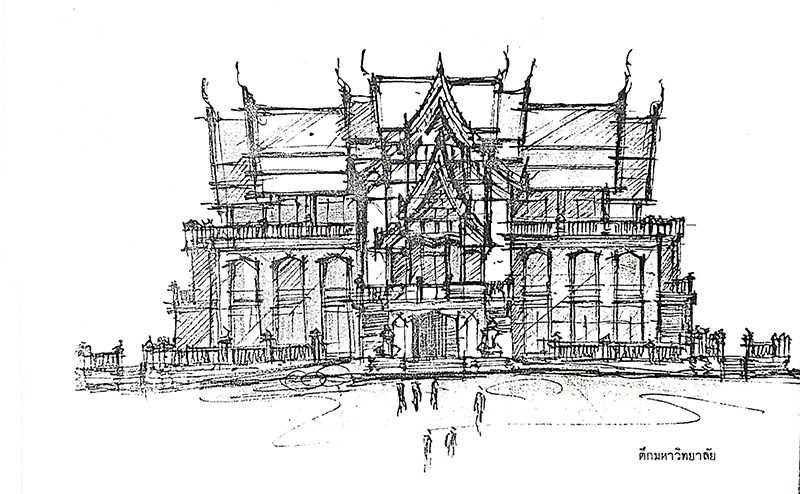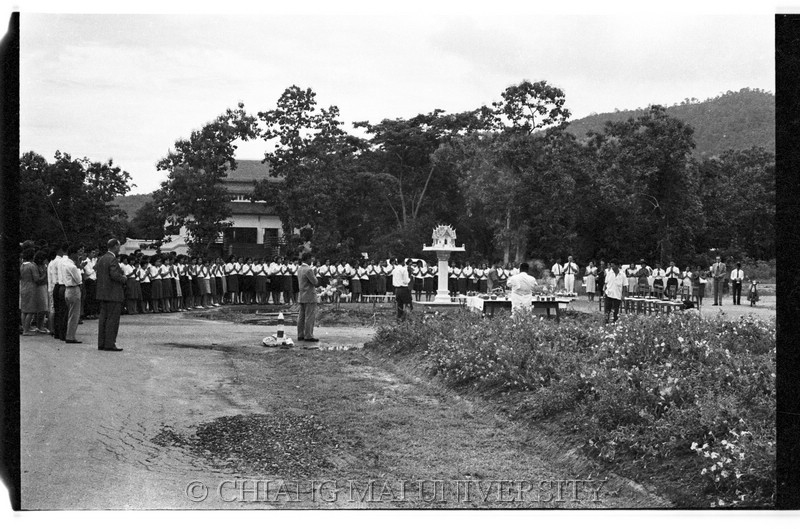What lies behind the iconic red doors of Chiang Mai University’s Dharma Pavilion?
Generations of students, since the formation of the university in 1964, have been curious. What secrets do the nearly permanently-closed red doors at the front of the structural heart of the university hold?
Let’s find out.
The opulent hall may appear to be rather empty at first glance, but there are a couple of special objects housed here. Seamlessly embedded in the wall to the left of the Chiang Mai University sign (on the right side of the photograph), is the Foundation Stone, which not only marks the inception of the university, but also proclaims its origins, background, faith and philosophy.
Prime Minister Sarit Thanarat at the ceremonial laying of the Foundation Stone
In 1962, two years before the university officially opened its doors, the founding committee had begun to explore the idea for the construction of a University Building. The building, aimed to house the university’s main administrative offices, was to be prominently seen upon arrival through the university gates, while also blending seamlessly with surrounding nature. The design must showcase the best of Thai cultural heritage through its architecture. A main road was built to lead up to this soon-to-be building, which had at that point received approval for both design and construction. In anticipation, Prime Minister Sarit Thanarat came to Chiang Mai on the 2nd October, 1962, to officiate over the laying of the Foundation Stone.

The ceremonial laying of the Foundation Stone is a joint Buddhist and Brahman tradition and a common practice across Thailand. The stone, inscribed with Thai astrological signs and deemed to have been imbued with the highest order of astrological alignments to bring good fortune to business as well as to governance, was therefore placed on what was then a yet undeveloped area (under the bridge which runs towards the Dharma Pavilion today).
The construction of the bridge over the Foundation Stone
 The first design for the Dharma Pavilion
The first design for the Dharma Pavilion
It was soon evident that the business of administration was incompatible with the initial dual purpose of the building – to also stand as a cultural landmark. The daily bustle was discordant with the gravity of the symbolic building, and it was then decided to separate the two; one building to represent the university and another to be a place to conduct administrative duties.
The administrative building was therefore constructed first, with the left over budget used to build the ‘back hall’ of the Dharma Pavilion, while awaiting the next annual budget to arrive in order to construct the main building.
Upon the completion of construction
His Serene Highness Prince Samai Chaloem Kritakara, architect for the Dharma Pavilion
The ‘back hall’ is a two-story Thai-style building containing a hall 20 metres long and 12 metres wide. The hall was designed by His Serene Highness Prince Samai Chaloem Kritakara, previous head of architecture at the Fine Arts Department as well as ex dean of Faculty of Decorative Arts, Silpakorn University. Renowned for his works in Thai-style architecture, which included such important buildings as Bangkok’s Sala Chalermkrung Royal Theatre, Bhubing Palace, and the Bangkok Metropolitan Administration, he was assisted by fellow architect, M.R. Mitraroon Kashemasr?
This building was completed on the 9th January 1964, and though the original plan for two buildings was halted to accommodate the new administrative building where the president of the university works, a bridge was built to connect the road by the roundabout to the building which had its name officially changed to Dharma Pavilion. Over the years, this building would be used for the university’s religious and other important ceremonies, as well as having become the official changing room for His Majesty King Bhumibol Adulyadej during his annual visits to hand out degree certificates.
Their Majesties King Bhumibol Adulyadej and Queen Sirikit at a graduation ceremony, Sala Ang Kaew
According to Emeritus Professor Dr. Vanpen Surarerks, of the Faculty of Social Studies’ Department of Geography, whose father Major General Pison Surarerks was a renowned astrologer, there were two mistakes made in the initial laying of the foundation stone. The first were some misalignments of astrological factors while the other was the placement of the stone itself, which now had a footbridge inappropriately crossing over it. In order to fix these errors, it was decided that a ceremony should be held to pour out thonglor gold for the university’s Buddha image, an event presided over by His Majesty King Bhumibol Adulyadej. It was also deemed important to erect a spirit house for the university, the task completed in July 1964. Finally, during the leadership of Professor Boonsom Martin who was president of the university between 1971-1973, the stone was officially moved to its current location in the Dharma Pavilion. Thus, the spirits were appeased.

Ceremonial erection of the spirit house
The two Buddha statues at Dharma Pavilion
As to the university’s Buddha statue, visitors to the Dharma Pavilion fortunate enough to get a glimpse inside, will find two Buddha statues, one in front of the other, creating serenity for the space. The first sits at the back of the hall. Phra Buddha Tossaphon Chinnarat, at 60 inches across the lap, was brought here from Bangkok’s marble temple, Wat Benchamabophit, placed in its current location in celebration of the university’s 20th anniversary in 1985. The statue was officially named by His Majesty King Bhumibol Adulyadej two years later. The statue to the front, Phra Buddha Ping Nakaraphimongkol, named by Somdet Phra Sangharajachao Krom Luang Vajiranayanasamvara was built in 1996 to mark two significant occasions – the 50th year on the throne of His Majesty King Bhumibol Adulyadej and the 700th anniversary of the founding of Chiang Mai.
Upon the visit of His Majesty King Bhumibol Adulyadej on the 24th January 1997, a miniature of the Buddha statue was offered to him.
Chiang Mai University’s first sign
The second object of importance to be found in the Dharma Pavilion is the original university sign. Designed by university lecturer Prasong Panyaphet, the distinctive sign using the popular printing font of its day, was removed after years of wear and tear to add the English and Lanna languages to the new sign.
Chiang Mai University’s current sign, designed by graduating class 13
Today’s ‘Chiang Mai University’ sign, which stands on Huay Kaew Road, was designed by graduating class 13 and was inaugurated on the 24th January 2010. The name of the university itself is yet another factor which differentiates the university from all others in Thailand. Chiang Mai University was the first university in the nation to be named after a province, according to M.L. Pin Malakul who recorded the founding history of the university. Most universities up to then were named after the king who endowed it, or following its specialisation.

The origins of the Dharma Pavilion may have differed from today’s purpose, but the elegant and distinctive building seen at the end of the boulevard from the university’s main gate, has established itself as a symbol of the university. Imbued with history, culture, beauty and memories, everyone who visits the beautiful campus of Chiang Mai University can’t help but find themselves gazing at this historical symbol of the North’s premier seat of learning.